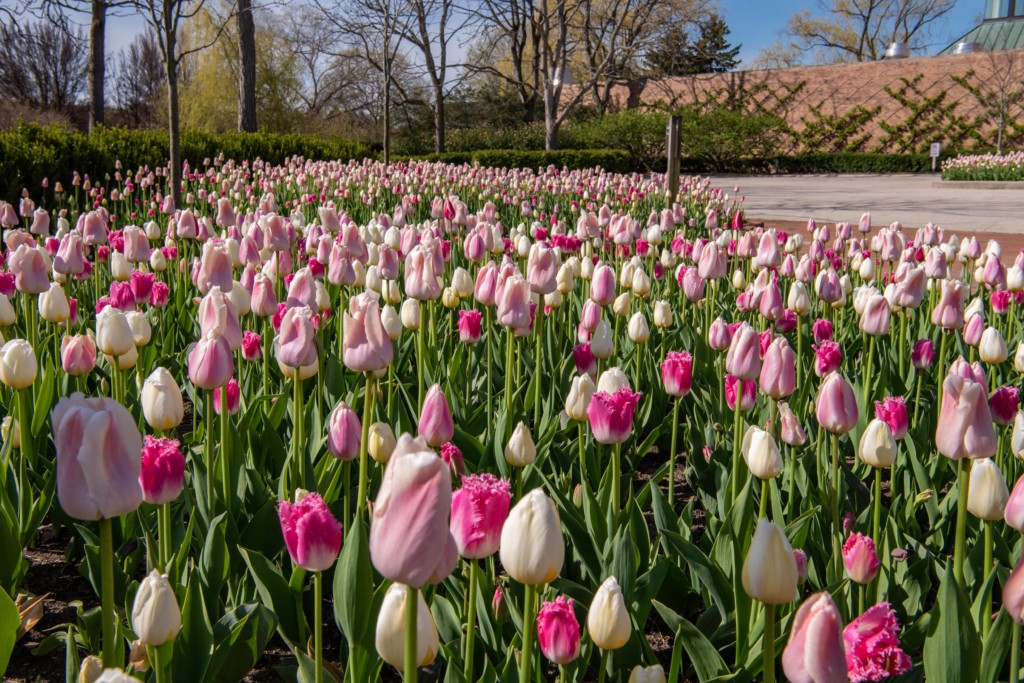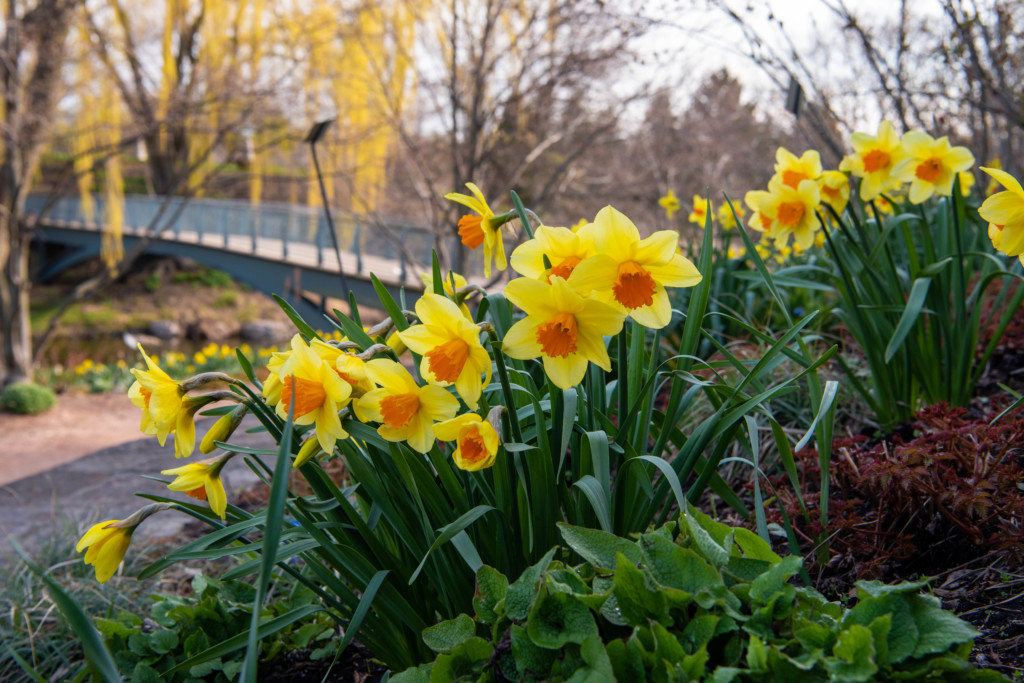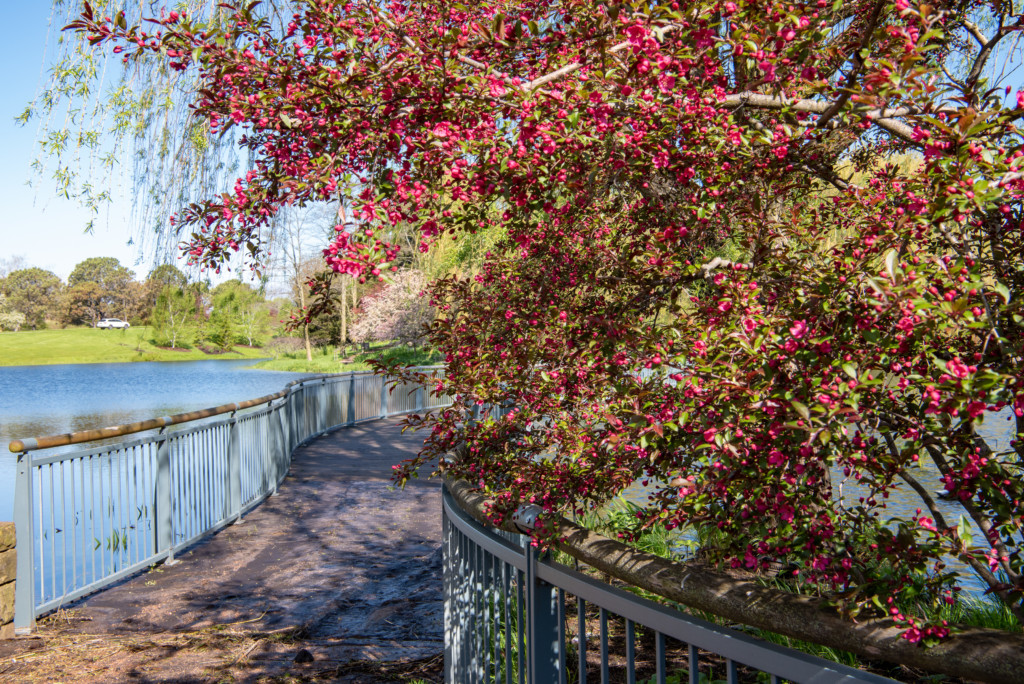With hundreds of thousands of vibrant flowers and trees in bloom, bees buzzing and birds chirping, there’s no better place to celebrate spring than at Chicago Botanic Garden in Glencoe.

A visit to the garden is an opportunity to relish the beauty of the outdoors — an experience that was unavailable at this time last year. Like theaters, concert halls, restaurants, museums, and many other places, the garden was closed during the spring season last year due to the Covid-19 pandemic.
The flowers continued to bloom despite the closure and work to maintain and beautify the 385-acre property never came to a halt even when the garden was closed to visitors.
“We had a critical team that continued to care for our 2.6 million plants and the production greenhouses during the closure,” says Julie McCaffrey, public relations manager.
Indeed, what might be termed a downtime was actually quite a fertile period when one considers that 95,000 tulips and other annual bulbs were planted in the fall.

Those bulbs are now bursting into color and are not to be outdone by fields of sunny daffodils that have emerged from the garden’s 450,000 daffodil bulbs.
“We’re inviting people to come and walk around and see the flowers,” says McCaffrey. “The daffodils right now are really spectacular. The fields of yellow daffodils are the big ‘Wow.’”

The spring season that stretches through May and into late June is far from static and will roll out in wave after wave of color, scent and motion, McCaffrey says.
A visit to the garden promises to provide visitors with the chance to indulge not just their sight, but their senses. They will hear birds chirping, see insects fluttering, and inhale the fragrant scents of an ever-changing floral landscape.

“Spring is truly a spectacular time to walk around our garden and see what’s blooming each day throughout the season,” says Fred Spicer, executive vice president and director.
Any time in the coming weeks will be a good time to visit the garden, McCaffrey says.
“The color increases every week. There are multiple peaks of color,” she notes.
The weather has been warm which means that some of the garden’s highlights may bloom a little earlier than in years past. Hundreds of fragrant crabapples that create a cathedral of scent and color at the Lakeside Garden (one of the gardens within the botanic garden) are expected to bloom by early May if not sooner. Other flowering trees that visitors will enjoy are magnolias and cherry blossom trees.

The garden’s website offers a listing of the flowers in bloom and there is an app called the Garden Guide that visitors can download to locate various plants.
“The Garden Guide has a lot of helpful features like walking tours and you can look up plants and mark them as favorites and you can find the locations of plants you want to see,” she says.
McCaffrey says people who’ve been stuck inside during the long months of winter and by the even longer months of the pandemic are craving the chance to be outdoors and to enjoy the natural world.
“People are really hungry for color scent and motion,” she said. “People want to hear the birds singing and the bees buzzing. A visit to the garden is a spring break of sorts.

“Just hearing the birds chirping fills you with hope,” she said. “It’s really uplifting.”
The garden, which is owned by the Forest Preserves of Cook County and operated by the Chicago Horticultural Society, is a living plant museum featuring 27 distinct gardens and four natural areas. Admission is free, but parking costs for non-members ranges between $10 and $30.
The garden at 1000 Lake Cook Road is open daily from 8 a.m. to 7 p.m. Due to Covid-19, all visitors, including garden members — must preregister for timed entry.
For information, call 847-835-6801 or visit chicagobotanic.org.
More from Better:
- 30 of the Best Things to Do in Chicago and the Suburbs in April
- Bill Gates Says We’re On a Path to Climate Disaster — But He Has a Plan to Avoid It
- 15 Chicago Photographers Share Their Favorite Photo of the Year

Annemarie Mannion is a freelance writer and former reporter for the Chicago Tribune. She earned a Master’s Degree in Journalism from Northwestern University and a degree in English Literature from St. Mary’s College in Notre Dame, Indiana. She is especially passionate about covering nonprofits. Whether writing about work to reduce the harmful effects of bright lights on sea turtles or covering volunteers’ efforts to address the health care needs of children in Guatemala, she loves spreading the word about initiatives that have the potential to change the world for the better.

